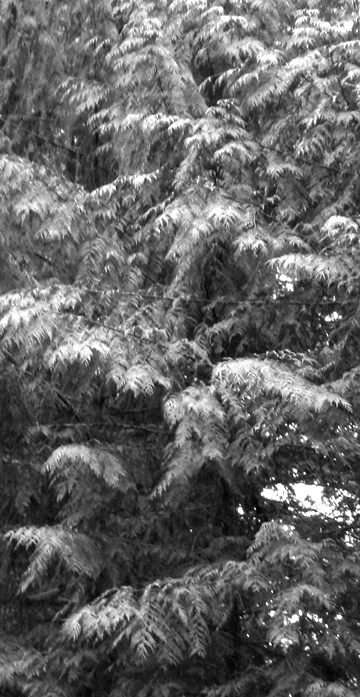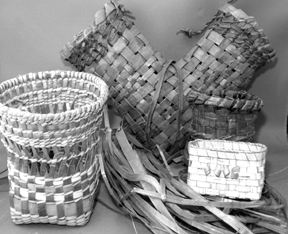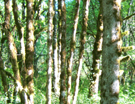Chapter 3: The Best Conifers
From A Guide to Innovative Tree Farming in the Pacific Northwest by Mike Dubrasich. 2005. Whirlwind Press. For a hard copy of the book ($10 - includes shipping) please contact W.I.S.E. [here].

Best of the Best: Western Red Cedar (Thuja plicata)
Runners-Up: Alaska Yellow Cedar (Chamaecyparis nootkatensis), Redwood (Sequoia sempervirens)
Honorable Mention: Noble fir (Abies procera)
There are thousands of native plant species in the Pacific Northwest. Hundreds have some commercial potential as tree farm crops. From these I have selected 15 species that I consider to be the best native plants for innovative tree farming. All 15 can economically out-perform Douglas-fir many times over. Innovative tree farmers are growing many more native species than these, but the 15 selected are the best, in my opinion.
I have divided the best species into four groups: conifers, hardwoods, shrubs, and herbaceous plants. Yes, shrubs and herbaceous plants; innovative tree farmers grow multiple species and harvest multiple products from every acre. From each group I have chosen the Best of the Best, the Runners-Up, and the Honorable Mentions. In this chapter I discuss the best conifers. In the next three chapters I discuss the best hardwoods, shrubs, and herbaceous plants.
Conifers are cone-bearing trees with naked seeds (pine nuts do not have shells). Conifers include pines, firs, cedars, cypresses, hemlocks, yews, larches, and Douglas-fir (Pseudotsuga menziesii). Conifers are also called softwoods, although the actual hardness of conifer wood varies greatly between species.
Western Red Cedar
Western red cedar is the best conifer species to grow on individual and family tree farms in the Pacific Northwest. Cedar produces multiple high-value products, starts producing income at a surprisingly young age, is easy to grow, and provides many opportunities to add value.
The natural range of western red cedar is from southeast Alaska to northern California and east to the Rocky Mountains. Cedar commonly occurs in wet habitats and on poorly drained soils, but people have planted it all over the world. Western red cedar is not a true cedar; taxonomists place it in the arborvitae genus, and arborvitaes thrive in many habitats.
Historically, western red cedar has been the tree species most valued by people in the Pacific Northwest for at least 10,000 years. The indigenous residents used cedar for walls, roofs, flooring, clothes, canoes, tools, furniture, baskets, mats, totem poles, cooking utensils, and much, much more. The Indians worshiped cedar as a supernatural being, and called her Life Giver and Long Life Maker . Modern uses of cedar are even more various, although our cultural connection to the species is not religious. Cedar is still a very expensive commodity, a fact greatly appreciated by the tree farmers who grow it.
One attractive feature of western red cedar is that nearly every part of the tree is useful, including roots, boughs, branches, bark, and wood. Cedar saplings can be pruned for commercial boughs and branches, called withes, starting at age 10 or so. Since the boughs and withes are salable products, pruning cedar is income-producing rather than an expense. Moreover, the pruning results in clear wood and bark, increasing the value of the final harvest products many-fold.
Clear western red cedar wood is decorative, not structural. Cedar wood is aromatic, multi-hued, and valued for beauty, not strength (“beauty” may be hard to define or explain, but the market pays dearly for it). The inner bark and fine roots of western red cedar are also beautiful, and are the most desirable craft fibers grown in the Pacific Northwest. Inner bark and roots are used for basketry, furniture making, and other fiber arts. A 30-year-old cedar, clear of knots to 25 feet, can possess $100 worth of inner bark and harvestable roots. The inner bark of a 50-year-old cedar may worth $150 by itself, while the clear (decorative) wood inside is worth five times the (structural) wood in a 50-year-old Douglas-fir. Meanwhile, for 40 years since the tree was 10, the innovative cedar farmer has been harvesting $5 to $10 in boughs and withes from that tree every year.

Western red cedar has two limitations for tree farmers: it grows faster in wet climates, and it likes shade. Cedar trees do better when companion-planted with hardwoods. Most native hardwood trees have faster sapling height growth than cedar, and when planted at the same time provide beneficial partial shade.
Combined plantings of hardwoods and western red cedar can be as dense as Christmas trees: over 1,200 trees per acre. The hardwoods reach harvestable size first, and their removal increases the growing space for the cedars just when they need it. Young stands can be thinned for bark and the best cedars (and hardwoods) left to grow into valuable decorative wood. To add another synergy, hardwood leaf litter tends to sweeten acidic soils, which improves cedar growth.
Many western red cedar harvest products can be processed rather than sold raw. Processing increases the sales price. If the processing is cheap and easy to do, the tree farmer can boost profits. For instance, peeled, cut, and dried inner bark strips are more valuable than raw bark. Strips of western red cedar inner bark, six feet long and ½ inch wide, retail in packs of twelve for $10 or more. A handy and creative tree farmer can further process bark and roots into finished baskets, furniture, or other art/craft products. This takes a lot more effort than preparing and packaging. Not all value-additions are profitable, although many are. It depends on the talent, determination, and genius of the individual tree farmer.
Alaska Yellow Cedar and Redwood
Alaska yellow cedar and redwood are tree species very similar to western red cedar. All three species produce similar multiple products. All three have been economic mainstays of their respective regions since human beings first arrived. All three can easily out-profit Douglas-fir on the right sites.
Pound for pound Alaska yellow cedar is the most valuable of the three species, but is thought to be limited to cold, wet climates. This is not always true, however. The heart of Alaska yellow cedar’s natural range is coastal British Columbia, but companion-planting with hardwoods can extend its range. Specimens grow very well in Oregon’s Willamette Valley. Pruning is required to grow high-value clear wood and inner bark. On the right site (cold and wet) Alaska yellow cedar is a great tree species to grow.
Redwood naturally occurs along the northern California coast, but trees have shown excellent growth in other habitats. Redwoods have some nice features: they are the fastest growing tree in the Pacific Northwest, they stump sprout, and they form burls. Redwoods will out-grow any other native tree in height and diameter; fast growth is very desirable in tree farming. Pruned trees yield clear wood, and as with cedars, the boughs are salable. Traditionally, clear heartwood from old-growth redwood trees (and cedars) has been the most-valued wood grade, but almost all the old-growth that can be logged has been logged. Clear wood from second-growth trees of all three species will be the premium grade of the future.
Redwood growers do not need to replant trees that stump sprout, and sprouts are much more vigorous than planted seedlings. Redwood trees and living stumps also form burls. Burls are very valuable, and rare in wild trees. Tree farmers can induce redwoods to burl by repeated pruning of stump sprouts or otherwise gently wounding trees near the base. It can take many decades for burls to achieve market size and quality, but their high value can enhance the profits from an already profitable crop.
Redwood inner bark does not have the desired qualities, or historical endorsement, that inner barks of western red cedar and Alaska yellow cedar have. Inner bark is a great tree farm product because it can be harvested from relatively young trees. I prefer growing one or both of the cedar species to redwood, just because of the profit opportunities inner bark provides. However, redwood is a close third choice because of its amazing growth rates on good soils.
Noble fir
Noble fir merits Honorable Mention for one reason: it is the best Christmas tree species. Other tree farm products, such as the multiple products from western red cedar, make more money with less effort, but Christmas trees are a nice addition to other innovative tree farm income.
Noble firs are slower growing than other Christmas tree species, but they are worth more per foot. They also require much less culturing than other species. Shearing Christmas trees is a big expense; noble firs do best without shearing. Moreover, naturally misshaped noble firs can be used for bough trees.
All the best conifers produce high-value commercial boughs. Innovative tree farmers sell most of their boughs to nurseries and florists for Christmas wreathes, or make and market their own wreathes. Bough prices today vary from 50¢ to $1 per pound of clean, clipped branch tips from the most desired species. Bough orchards can produce 3 to 5 tons of boughs per acre per year. Annual income compounds much more quickly than periodic income; hence bough orchards can easily out-produce Christmas trees in profit per acre per year.
Eventually bough trees get too tall to easily prune. If they are noble firs, innovative tree farmers thin them, harvest the remaining boughs, and sell the tops as Christmas trees. Western red cedars are thinned for their remaining boughs, inner bark, withes, and roots, as well. The best trees are left for further growth; pruned trees put on a layer of clear wood every year.
Conifers are great trees to grow, but not all of them make the grower a decent profit. Western red cedar, with its multiple products, is the most profitable native conifer species to farm in the Pacific Northwest.
by jose javier

What is your opinion about the production of truffles of Oregon (tuber gibbosum, tuber oregonense and leucangium cartlyuonii and leucangium brunneum. I have read in Spain that there is an enterprise (New World Truffieres) who plant Douglas-fir inoculated with truffles. Thanks